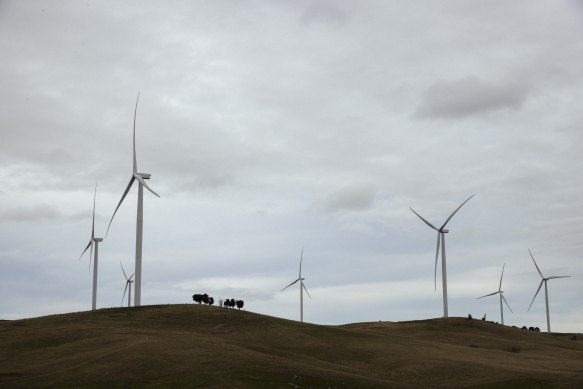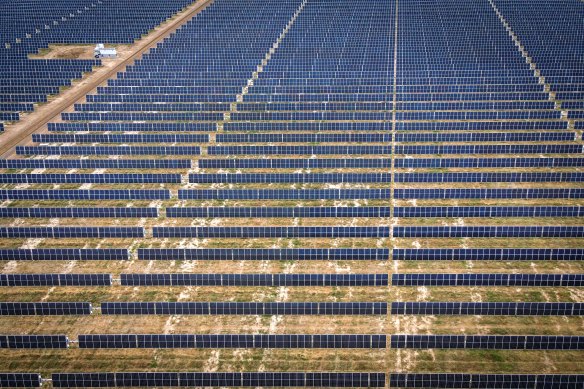- Exclusive
- Environment
- Climate change
- Renewables
This was published 7 months ago
State government plans to slash big renewables planning process
The NSW government is seeking to accelerate the approvals process for grid-scale renewable energy projects after complaints from the industry that it was the slowest and most cumbersome in the country and was thus hampering efforts to reach net zero targets and replace the state’s ageing coal fleet.

Wind turbines tower over cattle on property owned by Charlie Prell near Crookwell in NSW.Credit: Dominic Lorrimer
On Tuesday, the Minns government will release five new sets of guidelines designed to give local communities and renewable energy developers more clarity about what should be included in development applications.
Speaking to The Sydney Morning Herald, Planning Minister Paul Scully and Climate Change and Energy Minister Penny Sharpe said the changes were not designed to favour developers or communities, but to give all parties more certainty.
“It is about early ‘no’s’ as well as ‘early yeses’,” Sharpe said.
The announcement follows a report last year that showed the Queensland government took an average of 190 days to make a ruling on a wind development; in NSW it was 3488 days, or 9.5 years. As a result, NSW was losing investments in renewables to other states.
The government hopes new applications will be decided upon within 100 days, though that timeframe could be extended by requests for further information.
Scully said that in addition to the new guidelines, more staff had been put in place to consider applications and that the entire sector should now be aware the fast processing of renewable energy applications was a government priority.
The guidelines will include advice on how the planning process will consider applications for wind and solar projects, as well as proposed new transmission lines; how benefit-sharing schemes to pay local communities for hosting developments will be considered; and how developers and private landholders can arrive at private agreements.
“There was a general criticism that the NSW planning system was not working to get projects under way,” Scully said. “We needed to provide confidence and certainty across the board. Now, that’s confidence and certainty to proponents, to communities, to the investment community, to councils, about how this was going to work.”
The wind guidelines will detail how proponents of new projects should assess the visual impact of their proposals, and include a calculator to show how they should ascertain appropriate setback from other homes, towns and cultural sites to mitigate impact. They will include a calculator to estimate the cost of decommissioning wind turbines at the end of their lives, so those costs can be agreed to up front.
The section on the visual impact of wind turbines says a 240-metre turbine can have a dominant appearance to a distance of 1.5 kilometres when it is completely visible.

A solar farm on the outskirts of Gunnedah, NSW. Credit: Bloomberg
Benefit-sharing guidelines will detail how much money proponents should consider offering not only to landholders thinking of hosting wind farms, but to neighbours and communities, and how that money may best be delivered to the community.
“We’ve set some expectations around community benefit and how that flows to host communities,” Scully said. “It’s not a number set in stone, of course – proponents can go beyond it – but we’re putting a minimum expectation out there of $1050 per annum per gigawatt of wind generation, $850 for solar, $150 for battery and energy storage.”
These expected payments do not include the fees paid directly to landholders who are directly affected by wind developments, and the state government expects 85 per cent would go directly to local councils.
Similarly, the guidelines on private agreements will outline how such agreements have worked most effectively to date and what the government expects to see in them.
“Rather than saying, ‘Here’s a template agreement’, what we’ve said is: ‘Here’s a guide to how individuals and the industry should come together to make these agreements; here’s some model clauses that you may wish to incorporate in into your agreement’,” Scully said.
As state and federal governments have sought to ramp up the deployment of grid-scale renewable energy projects, tensions have increased in some communities between those who welcome the developments as a secure secondary source of income and those who fear they will damage the amenity and productivity of the land.
Clean Energy Investor Group chief executive Richie Merzian welcomed the guidelines, saying their release demonstrated the government was listening to the concerns of the industry. But he said he would like to see more detail.
Energy consultant Stephanie Bashir, principal of Nexa Advisory, said the government was not showing sufficient urgency in speeding up the deployment of renewables in time to meet expected energy shortfalls caused by coal closures.
She said the guidelines might speed up future applications, but she said they would do little to clear the logjam of applications in the system.